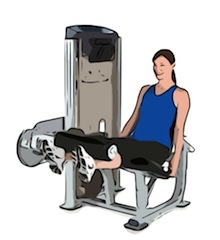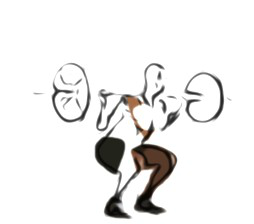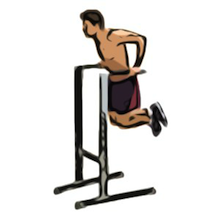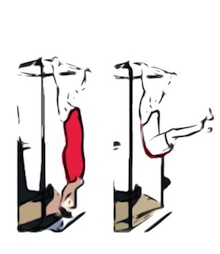Can you provide alternative exercises that accomplish what these exercises are supposed to?
- You are here:
- Home »
- Blog »
- Fitness After 40 »
- The Seven Most Overrated Exercises You Can Stop Doing
The Seven Most Overrated Exercises You Can Stop Doing
I discovered, from my research into why people exercise, that there are two main reasons and they change in priority by age ranges.
If you’re under 40 years of age, the main reason you exercise is to mold your body into something you think someone else will be attracted to. You want to look sexy and attractive and you think that’s looking like whatever the media portrays so you haul your butt to the gym, pound the pavement, buy things like P90x and Insanity dvds chasing the holy grail of body image.
If you’re over 40, your health is your primary concern. You sense “old age” galloping up behind you and you don’t want it to catch you. So, exercise for you is more of an inoculation against aging than looking like a fitness model.
Keep in mind that I said “main” or “primary” in each case. These are middle of the bell curve assessments so please don’t get twisted about how you’re NOT in these categories. Exceptions happen. People over the age of 40 care about their appearance but it’s not the primary motivation to exercise. And I know plenty of people under the age of 40 who care about their long term health.
I think it’s safe to say that neither camp wants to run the risk of injury and no one wants to spend more time exercising than they need to.
With that in mind, what you choose to do when it comes to exercise will have a large impact on your ultimate objective.
The Seven Exercises You Can Stop Doing
Bench Press
Not too many women spend time on the bench press. This is an exercise men use to boost upper body strength but in reality what they’re after is a bigger chest. Bad idea? In my opinion, yes. The drill requires great control of your lumbar spine, good hip flexibility and a movement pattern that is counter-intuitive. While it looks like all you do is press the bar straight up and down, the proper movement pattern has a more elliptical shape which if you’re unable to perform the movement properly, it’s a lot easier to hurt your shoulder. And, you should have a spotter unless you’re okay courting serious injury. You’ll see this drill in some competitive sports like football but you’re not playing football. You’re in this to be healthier.
Leg Extension
High patellafemoral (knee cap) forces make this exercise risky for most people. Why do people do it? To strengthen their quads. Does it work? Sure it does but at what cost? And what’s the practical, everyday functional improvement from this drill? Nothing. So, you’re not only wasting your time but courting a cartilage injury. And, you have to go to the gym to do it.
Sit Ups
The objective of a sit-up is to “strengthen” or “tone” your abdominal muscles (and the same is true for a V-Up or Crunches). But, the abdominal muscles work mostly in the first 30 degrees of the movement. After this, your hip flexors kick in and pull you up into sitting (which is even more pronounced when you anchor your feet by someone holding them or sliding them under something heavy). Because of this, the shear force created in the spine by the hip flexors is very large which is why most researchers will tell you, “Don’t do sit ups.” People still do them because they think a.) you can exercise away excess belly fat or b.) you’ll look better without a shirt on. Neither is true.
Barbell Squat
There are two reasons I include the Barbell Squat in this list.
One – you need a barbell which means you also need a spotter (and if you’re squatting with heavy weight – keeping mind that “heavy” is relative- you should have two spotters). You’re moving a large mass through space and if anything unusual should happen, like you get a cramp or something hurts, you could easily lose control of the movement and get seriously hurt.
Two – most people can’t maintain the proper lumbar position through the squat motion because they do not have the core strength or control to manage both the weight and the movement pattern. The result is the lumbar spine flexes which is one of the worst things you can have happen – a heavy load on a flexed lumbar spine.
Back Extension – Roman Chair
Moving your back into an extended position against a load creates two main problems. First, compression forces within the intervertebral disc rise to high and dangerous levels and second, the resistance can create a shearing force in the spine (the force created by one object sliding on top of another). Neither of those situations are worth the limited gain of muscle strength.
Dips
This exercise is often used in an attempt to “tone” the upper arm and develop strength in the shoulders. The risk you run is injury to the structures in the front of the shoulder because of the position created by the dip. The elbow is behind the shoulder and, in this position, the biceps tendon and rotator cuff tendon are exposed to very high forces.
Hanging Leg Raise
People have asked me if this exercise is good for “ab toning”  which is often a way of asking if the exercise will help flatten the belly and shape it. The short answer, like if I’m at a party, is no. The thing that helps you flatten your belly is losing excess body fat and no amount of leg raises will do that for you.
which is often a way of asking if the exercise will help flatten the belly and shape it. The short answer, like if I’m at a party, is no. The thing that helps you flatten your belly is losing excess body fat and no amount of leg raises will do that for you.
This is another exercise that creates too much compression load on the spine. Sometimes people will perform the movement with the knees bent but straight or bent, it doesn’t matter. The risk / reward is just too high.
But What About “Well Trained” Athletes?
You might assume that if you’re a well trained, competitive athlete that there really is no boundary; you can do whatever you want and not only survive it but thrive from it.
But, that’s simply not true. A competitive athlete wants to optimize his or her performance with the lowest risk of injury possible. Why? Because injuries are costly. Injuries can ruin careers, cost an athlete weeks or months of recovery and thousands or hundreds of thousands of dollars.
Smart athletes won’t just do something to brag about it or because someone says, “Hey dude, this is like totally bad ass. You’ll be trashed when you’re done!”
Bottom Line
Not all exercises are created equal. If you’re exercising to optimize your health then think about why you’re doing a particular exercise or movement and make sure that the risk/reward ratio is low enough for you.
